How to Dress as a Pioneer Woman
(1850s young woman wearing a fashion bonnet and jacket over her dress)
For a printable PDF of this article, click How to Dress as a Pioneer Woman.
If you are married, or older than 19, you are considered a woman in the mid-19th century.
With a little time and practice, you can make your own clothing at home, and dress like a pioneer woman.Undergarments
White or black stockings are at least knee length, and might be made in wool or cotton. Leather boots are very common footwear for crossing the plains, though some made the trek barefoot a large portion of the way. For safety reasons, plan to wear low-heeled, lace-up leather shoes or boots.
- A chemise (pronounced shem-eez’) is your first layer of underclothing. It is wide-necked, short sleeved, and hemmed between your upper calf and knee. White cotton is a good fabric for your chemise (white linen was also used in the past). In order to stay fresh and clean, you’ll want one chemise for each day of your trek or activity (or, one for each day between laundry days!).
- Stays or corsets are your mid-century bra. If you will be involved in pioneer events frequently, you’ll want to make stays. These gently mold the torso and support the bust; they also lend a great deal of back support during active work.
- Drawers are actually optional for adult women in the 1840s and 1850s, but you may feel more comfortable with them than without. White cotton drawers are cut full in the body and legs, and are hemmed about mid-calf. They will also keep your legs from chafing when you walk—very important to your comfort! You’ll need an equal number of drawers as chemises.
- Petticoats are full, gathered skirts, just a bit shorter (1” or so) than your dress. White cotton is a good fabric choice. They give your skirts the full, bell shape you’ll see in images of women from the pioneer era. They cut as wide as dress skirts (140”-180”); usually, at least one petticoat is worn—two or three are also common!
Dresses
Women in the mid-19th century most often wore one-piece dresses: a fitted or semi-fitted bodice with attached full skirts, all in one fabric. Your dresses should fasten at the center front with buttons or hooks.
Look for a small print, check, or plaid for your dress fabric. For ideas on historic printing styles and colors, visit www.reproductionfabrics.com. You will find many similar cotton prints in your local fabric stores. Women of the past also wore lightweight wool dresses. Look for a range of beautiful solids and plaids in tropical and summer-weight wool broadcloth.
Women’s dresses often use a high, “jewel” neckline (right at the base of your neck). Your dress takes shape through the bodice with gathers, pleats, or darts.
Long sleeves are the most common for women; these may be full (gathered to a cuff or band at the wrist), or narrow straight sleeves (often cut on the bias in the 1840s).
Skirts for women are hemmed from the top of the foot, to just above the ankle bones. Skirts are made full (140”-180” around) gathered or pleated to the bodice.
Aprons
With only one or two dresses as your entire wardrobe, you’ll use multiple white cotton or printed cotton aprons to keep your dress clean while you work. They do not need to match your dress at all. Aprons are usually fairly long (about 3/4 the length of your skirts), and can tie or button at the back.
Shawls
A shawl is your mid-19th century sweatshirt. It can be as simple as a 60” square of wool cloth, folded to a triangle and wrapped around your body. You don’t even have to hem it: a short self-fringe is one common edge finish. Shawls can be solid colors or plaid wool. (Shawls are an all-ages garment; young women use them, too.)
Sunbonnets
Your sunbonnet is a very important piece of clothing. It protects your scalp, ears, neck, face, and upper chest/back from sunburn. (You should also wear modern sunscreen!) The brim is stiffened with quilting stitches, narrow cording, or even slats of thin cardboard (similar to the back of a writing tablet.) The curtain is cut long to cover the neck and upper back. Your sunbonnet will generally not match your dress; choose a very lightweight, lighter colored cotton for your sunbonnet.
Hairstyles
Women commonly part their hair in the center. Smooth any bangs back into the rest of your hair. Most adult women wore their hair shoulder-length or longer, coiled into a bun or braided knot at the back of the head. Loose hair on women is not common (and tends to get pretty grimy on the trail—keep in mind you’ll get to wash your hair every few weeks!) Long, unpinned hair can also be a safety hazard—the last thing you want is to catch your hair in the axle of a cart or wagon, and be dragged under!
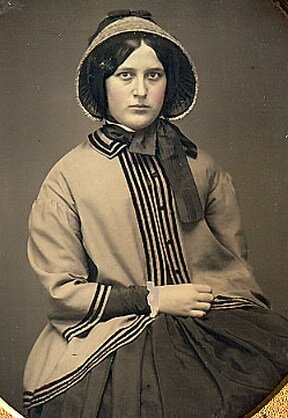
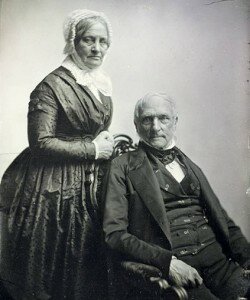
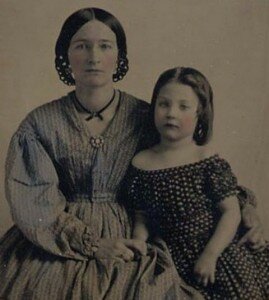
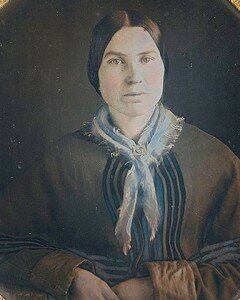
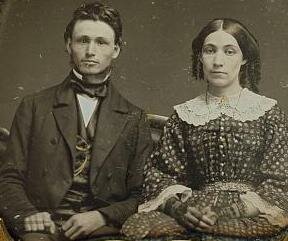
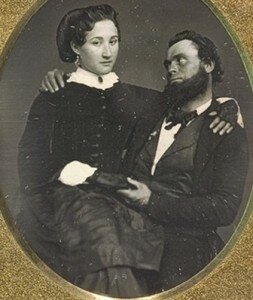
Pingback: 2015 Trek Patterns Update | Clothing the Saints